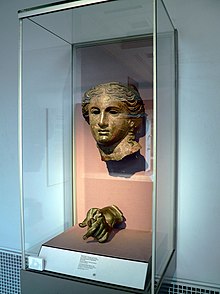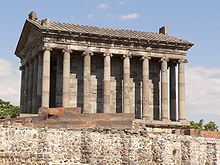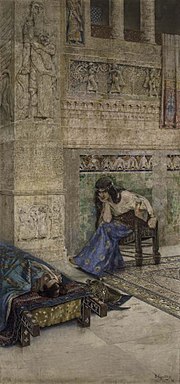
Shivini, also known as Siuini, Artinis, Ardinis, was a solar god in the mythology of the Iron Age kingdom of Urartu in the Armenian Highlands. He is the third god in a triad with Khaldi and Theispas. The Assyrian god Shamash is a counterpart to Shivini. He was depicted as a man on his knees, holding up a solar disc. His wife was most likely a goddess called Tushpuea who is listed as the third goddess on the Mheri-Dur inscription.
The Hurro-Urartian languages are an extinct language family of the Ancient Near East, comprising only two known languages: Hurrian and Urartian.
Urartian or Vannic is an extinct Hurro-Urartian language which was spoken by the inhabitants of the ancient kingdom of Urartu, which was centered on the region around Lake Van and had its capital, Tushpa, near the site of the modern town of Van in the Armenian highlands. Its past prevalence is unknown. While some believe it was probably dominant around Lake Van and in the areas along the upper Zab valley, others believe it was spoken by a relatively small population who comprised a ruling class.
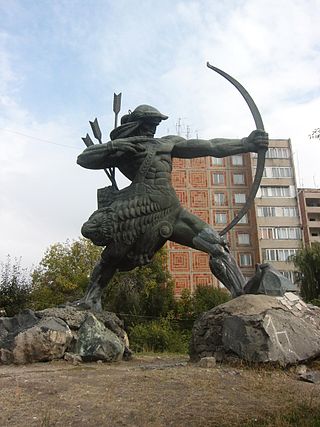
Hayk, also known as Hayk Nahapet, is the legendary patriarch and founder of the Armenian nation. His story is told in the History of Armenia attributed to the Armenian historian Moses of Chorene and in the Primary History traditionally attributed to Sebeos. Fragments of the legend of Hayk are also preserved in the works of other authors, as well as in Armenian folk tradition.

Ḫaldi was one of the three chief deities of Urartu along with Teisheba and Shivini. He was a warrior god to whom the kings of Urartu would pray for victories in battle. Ḫaldi was portrayed as a man with or without wings, standing on a lion.

Vahagn or Vahakn, also known as Vahagn Vishapakagh, is a warrior god in Armenian mythology. Scholars consider him to be either the thunder, or sun and fire god of the pre-Christian Armenian pantheon, as well as the god of war, bravery and victory. He formed a triad with Aramazd and Anahit. Vahagn is etymologically derived from *Varhraγn, the Parthian name for the Indo-Iranian god Verethragna, although there are key differences between the two deities.
Hayasa-Azzi or Azzi-Hayasa was a Late Bronze Age confederation in the Armenian Highlands and/or Pontic region of Asia Minor. The Hayasa-Azzi confederation was in conflict with the Hittite Empire in the 14th century BC, leading up to the collapse of Hatti around 1190 BC. It has long been thought that Hayasa-Azzi may have played a significant role in the ethnogenesis of Armenians.
Aramazd was the chief and creator god in the Armenian version of Zoroastrianism. The deity and his name were derived from the deity Ahura Mazda after the Median conquest of Armenia in the 6th century BC. Aramazd was regarded as a generous god of fertility, rain, and abundance, as well as the father of the other gods, including Anahit, Mihr, and Nane. Like Ahura Mazda, Aramazd was seen as the father of the other gods, rarely with a wife, though sometimes husband to Anahit or Spandaramet. Aramazd was the Parthian form of Ahura Mazda.
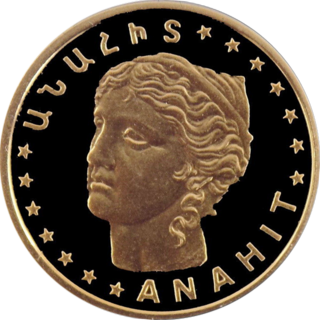
Anahit was the goddess of fertility and healing, wisdom and water in Armenian mythology. In early periods she was the goddess of war. By the 5th century BCE she was the main deity in Armenia along with Aramazd. The Armenian goddess Anahit is related to the similar Iranian goddess Anahita. Anahit's worship, most likely borrowed from the Iranians during the Median invasion or the early Achaemenid period, was of paramount significance in Armenia. Artaxias I erected statues of Anahit, and promulgated orders to worship them.
The origin of the Armenians is a topic concerned with the emergence of the Armenian people and the country called Armenia. The earliest universally accepted reference to the people and the country dates back to the 6th century BC Behistun Inscription, followed by several Greek fragments and books. The earliest known reference to a geopolitical entity where Armenians originated from is dated to the 13th century BC as Uruatri in Old Assyrian. Historians and Armenologists have speculated about the earlier origin of the Armenian people, but no consensus has been achieved as of yet. Genetic studies show that Armenian people are indigenous to historical Armenia, showing little to no signs of admixture since around the 13th century BC.
The name Armenia entered English via Latin, from Ancient Greek Ἀρμενία.
Astłik was the Armenian goddess of fertility and love, and consort of Vahagn. In the later pre-Christian period she became the goddess of love, maidenly beauty, and of water sources and springs.
Tzovinar (Ծովինար) or Nar (Նար) was the Armenian goddess of water, sea, and rain. She was a fierce goddess, who forced the rain to fall from the heavens with her fury.
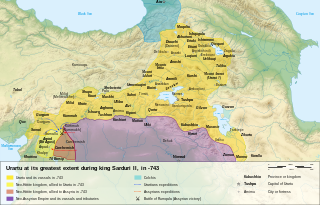
Urartu was an Iron Age kingdom centered around Lake Van in the Armenian Highlands. It extended from the eastern bank of the upper Euphrates River to the western shores of Lake Urmia and from the mountains of northern Iraq to the Lesser Caucasus Mountains. The kingdom emerged in the mid-9th century BC and dominated the Armenian Highlands in the 8th and 7th centuries BC. Urartu frequently warred with Assyria and became, for a time, the most powerful state in the Near East. Weakened by constant conflict, it was eventually conquered by the Iranian Medes in the early 6th century BC. Archaeologically, it is noted for its large fortresses and sophisticated metalwork. Its kings left behind cuneiform inscriptions in the Urartian language, a member of the Hurro-Urartian language family. Since its re-discovery in the 19th century, Urartu, which is commonly believed to have been at least partially Armenian-speaking, has played a significant role in Armenian nationalism.

Tork Angegh is a deity of strength, courage, manufacturing and the arts in Armenian mythology. A creature of unnatural strength and power, Tork was considered one of the great-grandsons of Hayk, the legendary patriarch of the Armenian people. He was reportedly represented as an unattractive male figure. He is mentioned by the early Armenian historian Movses Khorenatsi and is considered one of the significant deities of the Armenian pantheon prior to the time when it came under influence by Iranian and Hellenic religion and mythology. Taken in the context of Proto-Indo-European religions, it is conceivable that an etymological connection with Thor and Týr is more than a simple coincidence.
Nane was an Armenian mother goddess, as well as the goddess of war and wisdom.
Mihr is the deity of the light of heaven and the god of Sun in ancient Armenian mythology. The worship of Mihr was centered in a region named Derjan, a district in Upper Armenia, currently located in eastern Turkish territories. The temple dedicated to Mihr was built in the locality of Bagayarich. Despite the fact that the Armenian Mihr was less prominent in Armenia than Mithra was in Persia, Mihr is the root of many Armenian proper names such as Mihran, Mihrdat and Mehruzhan. The Armenian pagan temple Mehian also has the same source. The month of February was dedicated to Mihr and it was called Mehekan. In 301 A.D. Christianity became the official religion of Armenia, and the Armenian church adopted many pagan rites and ceremonies. For example, the Christian fire-festival of Trndez, which has pagan roots, is still celebrated in February, the month originally dedicated to Mihr.
Tir is the god of written language, schooling, rhetoric, wisdom, and the arts in Armenian mythology.
Etiuni was the name of an early Iron Age tribal confederation in northern parts of Araxes rivers, roughly corresponding to the subsequent Ayrarat Province of the Kingdom of Armenia. Etiuni was frequently mentioned in the records of Urartian kings, who led numerous campaigns into Etiuni territory. It is very likely it was the "Etuna" or "Etina" which contributed to the fall of Urartu, according to Assyrian texts. Some scholars believe it had an Armenian-speaking population.
The Urumu were a tribe attested in cuneiform sources in the Bronze Age. They are often considered to be one of the ancestors of the Armenians being one of the tribes which were part of the Armenian Hayasa-Azzi confederation.
